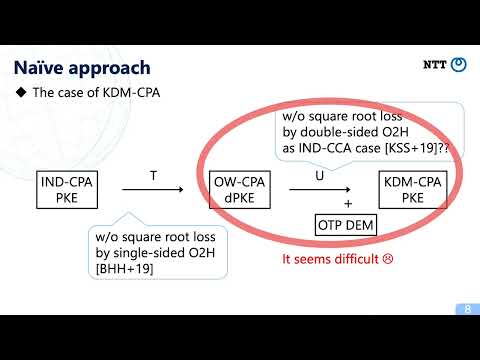CryptoDB
KDM Security for the Fujisaki-Okamoto Transformations in the QROM
| Authors: |
|
|---|---|
| Download: | |
| Conference: | PKC 2022 |
| Abstract: | Key dependent message (KDM) security is a security notion that guarantees confidentiality of communication even if secret keys are encrypted. KDM security has found a number of applications in practical situations such as hard-disk encryption systems, anonymous credentials, and bootstrapping of fully homomorphic encryptions. Recently, it also found an application in quantum delegation protocols as shown by Zhang (TCC 2019). In this work, we investigate the KDM security of existing practical public-key encryption (PKE) schemes proposed in the quantum random oracle model (QROM). Concretely, we study a PKE scheme whose KEM is constructed by using Fujisaki-Okamoto (FO) transformations in the QROM. FO transformations are applied to an IND-CPA secure PKE schemes and yield IND-CCA secure key encapsulation mechanisms (KEM). Then, we show the following results. - We can reduce the KDM-CPA security in the QROM of a PKE scheme whose KEM is derived from any of the FO transformations proposed by Hofheinz et al. (TCC 2017) to the IND-CPA security of the underlying PKE scheme, without square root security loss. For this result we use one-time-pad (OTP) as DEM to convert KEM into PKE. - We can reduce the KDM-CCA security in the QROM of a PKE scheme whose KEM is derived from a single variant of the FO transformation proposed by Hofheinz et al. (TCC 2017) to the IND-CPA security of the underlying PKE scheme, without square root security loss. For this result, we use OTP-then-MAC construction as DEM to convert KEM into PKE. Also, we require a mild injectivity assumption for the underlying IND-CPA secure PKE scheme. In order to avoid square root security loss, we use a double-sided one-way to hiding (O2H) lemma proposed by Kuchta et al. (EUROCRYPT 2020). In the context of KDM security, there is a technical hurdle for using double-sided O2H lemma due to the circularity issue. Our main technical contribution is to overcome the hurdle. |
Video from PKC 2022
BibTeX
@inproceedings{pkc-2022-31727,
title={KDM Security for the Fujisaki-Okamoto Transformations in the QROM},
publisher={Springer-Verlag},
author={Fuyuki Kitagawa and Ryo Nishimaki},
year=2022
}

